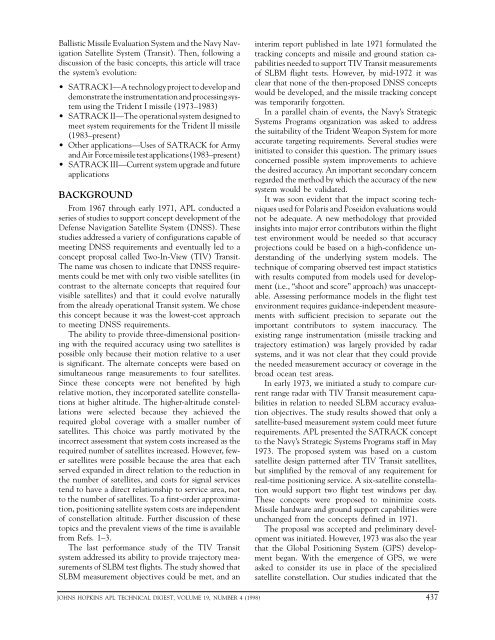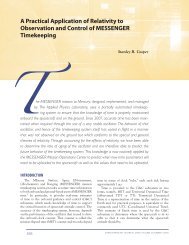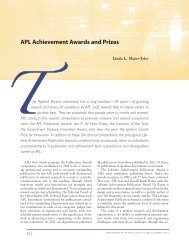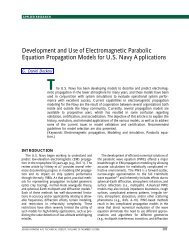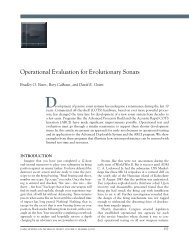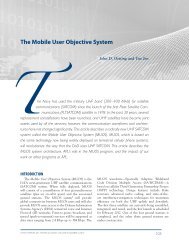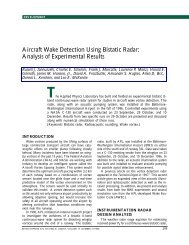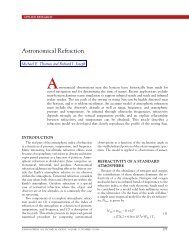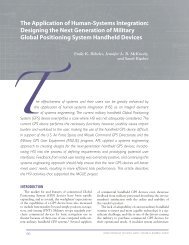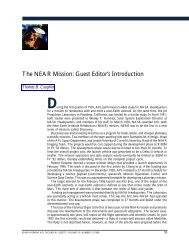The SATRACK System: Development and Applications
The SATRACK System: Development and Applications
The SATRACK System: Development and Applications
You also want an ePaper? Increase the reach of your titles
YUMPU automatically turns print PDFs into web optimized ePapers that Google loves.
Ballistic Missile Evaluation <strong>System</strong> <strong>and</strong> the Navy Navigation<br />
Satellite <strong>System</strong> (Transit). <strong>The</strong>n, following a<br />
discussion of the basic concepts, this article will trace<br />
the system’s evolution:<br />
• <strong>SATRACK</strong> I—A technology project to develop <strong>and</strong><br />
demonstrate the instrumentation <strong>and</strong> processing system<br />
using the Trident I missile (1973–1983)<br />
• <strong>SATRACK</strong> II—<strong>The</strong> operational system designed to<br />
meet system requirements for the Trident II missile<br />
(1983–present)<br />
• Other applications—Uses of <strong>SATRACK</strong> for Army<br />
<strong>and</strong> Air Force missile test applications (1983–present)<br />
• <strong>SATRACK</strong> III—Current system upgrade <strong>and</strong> future<br />
applications<br />
BACKGROUND<br />
From 1967 through early 1971, APL conducted a<br />
series of studies to support concept development of the<br />
Defense Navigation Satellite <strong>System</strong> (DNSS). <strong>The</strong>se<br />
studies addressed a variety of configurations capable of<br />
meeting DNSS requirements <strong>and</strong> eventually led to a<br />
concept proposal called Two-In-View (TIV) Transit.<br />
<strong>The</strong> name was chosen to indicate that DNSS requirements<br />
could be met with only two visible satellites (in<br />
contrast to the alternate concepts that required four<br />
visible satellites) <strong>and</strong> that it could evolve naturally<br />
from the already operational Transit system. We chose<br />
this concept because it was the lowest-cost approach<br />
to meeting DNSS requirements.<br />
<strong>The</strong> ability to provide three-dimensional positioning<br />
with the required accuracy using two satellites is<br />
possible only because their motion relative to a user<br />
is significant. <strong>The</strong> alternate concepts were based on<br />
simultaneous range measurements to four satellites.<br />
Since these concepts were not benefited by high<br />
relative motion, they incorporated satellite constellations<br />
at higher altitude. <strong>The</strong> higher-altitude constellations<br />
were selected because they achieved the<br />
required global coverage with a smaller number of<br />
satellites. This choice was partly motivated by the<br />
incorrect assessment that system costs increased as the<br />
required number of satellites increased. However, fewer<br />
satellites were possible because the area that each<br />
served exp<strong>and</strong>ed in direct relation to the reduction in<br />
the number of satellites, <strong>and</strong> costs for signal services<br />
tend to have a direct relationship to service area, not<br />
to the number of satellites. To a first-order approximation,<br />
positioning satellite system costs are independent<br />
of constellation altitude. Further discussion of these<br />
topics <strong>and</strong> the prevalent views of the time is available<br />
from Refs. 1–3.<br />
<strong>The</strong> last performance study of the TIV Transit<br />
system addressed its ability to provide trajectory measurements<br />
of SLBM test flights. <strong>The</strong> study showed that<br />
SLBM measurement objectives could be met, <strong>and</strong> an<br />
THE <strong>SATRACK</strong> SYSTEM<br />
interim report published in late 1971 formulated the<br />
tracking concepts <strong>and</strong> missile <strong>and</strong> ground station capabilities<br />
needed to support TIV Transit measurements<br />
of SLBM flight tests. However, by mid-1972 it was<br />
clear that none of the then-proposed DNSS concepts<br />
would be developed, <strong>and</strong> the missile tracking concept<br />
was temporarily forgotten.<br />
In a parallel chain of events, the Navy’s Strategic<br />
<strong>System</strong>s Programs organization was asked to address<br />
the suitability of the Trident Weapon <strong>System</strong> for more<br />
accurate targeting requirements. Several studies were<br />
initiated to consider this question. <strong>The</strong> primary issues<br />
concerned possible system improvements to achieve<br />
the desired accuracy. An important secondary concern<br />
regarded the method by which the accuracy of the new<br />
system would be validated.<br />
It was soon evident that the impact scoring techniques<br />
used for Polaris <strong>and</strong> Poseidon evaluations would<br />
not be adequate. A new methodology that provided<br />
insights into major error contributors within the flight<br />
test environment would be needed so that accuracy<br />
projections could be based on a high-confidence underst<strong>and</strong>ing<br />
of the underlying system models. <strong>The</strong><br />
technique of comparing observed test impact statistics<br />
with results computed from models used for development<br />
(i.e., “shoot <strong>and</strong> score” approach) was unacceptable.<br />
Assessing performance models in the flight test<br />
environment requires guidance-independent measurements<br />
with sufficient precision to separate out the<br />
important contributors to system inaccuracy. <strong>The</strong><br />
existing range instrumentation (missile tracking <strong>and</strong><br />
trajectory estimation) was largely provided by radar<br />
systems, <strong>and</strong> it was not clear that they could provide<br />
the needed measurement accuracy or coverage in the<br />
broad ocean test areas.<br />
In early 1973, we initiated a study to compare current<br />
range radar with TIV Transit measurement capabilities<br />
in relation to needed SLBM accuracy evaluation<br />
objectives. <strong>The</strong> study results showed that only a<br />
satellite-based measurement system could meet future<br />
requirements. APL presented the <strong>SATRACK</strong> concept<br />
to the Navy’s Strategic <strong>System</strong>s Programs staff in May<br />
1973. <strong>The</strong> proposed system was based on a custom<br />
satellite design patterned after TIV Transit satellites,<br />
but simplified by the removal of any requirement for<br />
real-time positioning service. A six-satellite constellation<br />
would support two flight test windows per day.<br />
<strong>The</strong>se concepts were proposed to minimize costs.<br />
Missile hardware <strong>and</strong> ground support capabilities were<br />
unchanged from the concepts defined in 1971.<br />
<strong>The</strong> proposal was accepted <strong>and</strong> preliminary development<br />
was initiated. However, 1973 was also the year<br />
that the Global Positioning <strong>System</strong> (GPS) development<br />
began. With the emergence of GPS, we were<br />
asked to consider its use in place of the specialized<br />
satellite constellation. Our studies indicated that the<br />
JOHNS HOPKINS APL TECHNICAL DIGEST, VOLUME 19, NUMBER 4 (1998) 437


